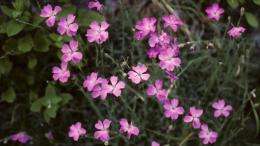Carnations show the fastest known diversification rate in plants

(PhysOrg.com) -- Scientists have discovered the most rapid speciation event currently known in plants – not in plants from the biodiverse rainforests or oceanic islands, but in the genus Dianthus in Europe.
As part of a EU-funded project on biodiversity hotspots, Luis Valente (PhD student), Dr Pablo Vargas (Madrid Botanical Garden) and project leader Vincent Savolainen (Imperial College London & RBG Kew) have found that carnations (Dianthus, Caryophyllaceae), a well known group of plants from temperate Eurasia, have diversified at the most rapid rate ever reported in plants or terrestrial vertebrates.
Using phylogenetic methods, they found that the majority of species of carnations belong to a lineage that is remarkably species-rich in Europe and arose at the rate of 2.2–7.6 species per million years.
A shift in diversification rates of carnations was detected that coincided with a period of increase in climatic aridity in the Pleistocene, suggesting a link between climate and biodiversity.
This explosive radiation indicates that Europe, the continent with the world's best-studied flora, has been underestimated as a cradle of recent and rapid speciation.
More information: Valente, L.M., Savolainen, V. & Vargas, P. (2010). Unparalleled rates of species diversification in Europe. Proc. R. Soc. B 277:1489–1496.
Originally published in Kew Scientist, issue 37, www.kew.org/kewscientist/ks_37.pdf
Provided by Royal Botanic Gardens, Kew

















